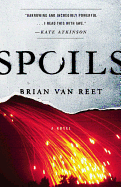
| Publisher: | Lee Boudreaux/Little, Brown | |
| Genre: | Literary, Fiction | |
| ISBN: | 9780316316163 | |
| Pub Date: | April 2017 | |
| Price: | $26 |
| Fiction |
by Brian Van Reet
In Brian Van Reet's Spoils, U.S. combatants in the Iraq War are a mix of aimless young volunteers, including Cassandra Wigheard, a 19-year-old army Humvee gunner; Sleed, a jumpy, go-along-to-get-along tank crewman; and Humvee driver Crump, "a class clown, C+ high school student whose primary social outlet was World of Warcraft." Among their adversaries ("itinerants, nomads, wanderers; young men banished from their homelands, lost to their parents") is Abu Al-Hool, an emir in the mujahideen, who fought previously in Chechnya and Afghanistan. As Van Reet summarizes in an early chapter, war is a young person's game: "the adult fear of death that makes taking the kind of risks you must take to personally win a ground war too unlikely a feat for anyone but a megalomaniac, a closeted suicide, or a teenager."
Spoils, however, is not just about the well-described ambience of the sand, heat, rains and stench of war, with its coarse soldier talk and extravagant weaponry--it's also a damn fine story. Weeks after invading Iraq, Cassandra's platoon is ambushed, and she, Crump and their sergeant are captured by Al-Hool's band of jihadists. It's all hands on deck to find the MIA prisoners, but Al-Hool's crew has them secreted in wet basement cells outside Fallujah. Smoothly, Van Reet's story of firefights transitions to a story of prison survival.
In every war, heroism is not just for those who win medals. Spoils is the story of those who rise to small acts of valor while no one is looking. When everything's on the line, war turns from boredom, mishap and mismanagement to a story of individual fortitude and moments of compassion. --Bruce Jacobs, founding partner, Watermark Books & Cafe, Wichita, Kan.
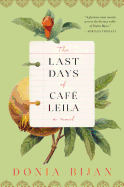
| Publisher: | Algonquin | |
| Genre: | Cultural Heritage, Family Life, Literary, Fiction | |
| ISBN: | 9781616205850 | |
| Pub Date: | April 2017 | |
| Price: | $25.95 |
| Fiction |
by Donia Bijan
Since Noor Yadegar was sent from her homeland of Iran to the U.S. as a teenager, she's missed her father, Zod, and their family's café, a neighborhood institution. After discovering her husband's infidelity, Noor heads back to her family's home in Tehran with her teenage daughter, Lily, in tow. The world they discover is both familiar and unknown to Noor and totally new to Lily. Iranian American chef and writer Donia Bijan--who also came to the U.S. as a teenager--paints a rich portrait of family, food, love and loss in her debut novel, The Last Days of Café Leila.
Although Noor came to Tehran hoping to escape her heartbreak, she must deal with the weight of her family's history and the realities of life in Iran, harsh and beautiful, gracious and violent. When Lily convinces Karim, the café's errand boy, to join her in a daring escapade, the resulting events will have consequences for the entire Yadegar household: Noor, Zod and the café's small staff of loyal employees. Meanwhile, Noor must confront her father's mortality and decide how she wants to shape her own future.
In the end, Noor comes to know what Zod and the café's employees have always known: "She couldn't change the conditions, she couldn't deny her awareness, and she couldn't stand in the way of death or love." She realizes that "the only thing to do was to keep moving, to do something, to show courage, to give everything she was capable of giving." Bijan's novel is a tribute to everyday resilience, love in the face of deep grief and the power of a good meal to nourish body and soul. --Katie Noah Gibson, blogger at Cakes, Tea and Dreams
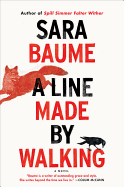
| Publisher: | Houghton Mifflin Harcourt | |
| Genre: | Contemporary Women, Small Town & Rural, Literary, Fiction | |
| ISBN: | 9780544716957 | |
| Pub Date: | April 2017 | |
| Price: | $25 |
| Fiction |
by Sara Baume
A Line Made by Walking, Sara Baume's second novel, takes its title from a 1967 artwork by Richard Long. He walked back and forth in a straight line across a field and photographed the resulting flattened path of grass--a testament to Long's existence. In Baume's novel, Frankie, a young woman struggling with mental illness and an unsettling shift toward adulthood, attempts to find her place in the world--and prove that place and her existence in it have meaning. Even the mud on the stoop left by her boots is comforting in its own way: "so I know I must exist after all--that I must still be here."
Baume (Spill Simmer Falter Wither) tells Frankie's story in a series of vignettes and introspections that read more like personal essays than a traditional novel. Though the story presses forward through time, with Frankie having a breakdown in her Dublin flat before moving to the countryside to live in her grandmother's bungalow in search of solitude, the narrative is interrupted with thoughts on art, observations about the natural world and reflections on happiness (and unhappiness). These interruptions make Frankie's story as scattered as her thoughts, though Baume weaves it together in a way that feels poignant and reflective, not disjointed. A Line Made by Walking is a quiet, meditative, beautiful story of one young woman's struggles with mental illness and adulthood, and her search for meaning. In Frankie's heartbreaking but hopeful story, Baume perfectly captures the disquietude of not knowing one's purpose in life--but persisting in searching for it. --Kerry McHugh, blogger at Entomology of a Bookworm
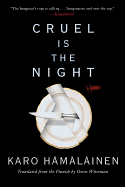
| Publisher: | Soho Crime | |
| Genre: | International Mystery & Crime, Mystery & Detective, Traditional, Fiction, Noir | |
| ISBN: | 9781616956813 | |
| Pub Date: | April 2017 | |
| Price: | $25.95 |
| Starred | Mystery & Thriller |
by Karo Hämäläinen, trans. by Owen Witesman
Karo Hämäläinen's Cruel Is the Night opens with multiple cell phones ringing in an apartment, but no one is answering.
Earlier that day, Mikko and his wife, Veera, arrive in London from Helsinki to visit their old high school friend Robert and his wife, Elise. Mikko has brought a deadly gift for his host, while Veera is carrying a secret about Robert. Elise also has a secret she's hiding from everyone--except for one person in the room. With hidden agendas and murderous intentions, will they all survive the evening?
Acclaimed Finnish author Hämäläinen makes his U.S. debut with this well-paced thriller, which unfolds over dinner one night. Chapters alternate among the lead characters' points of view, revealing how they really feel about one another, even as they maintain a veneer of civility. As the meal progresses and the alcohol flows, it becomes clear the built-up tensions will result in an explosion.
Before he gets to dessert, Hämäläinen raises thought-provoking questions and makes relevant political commentary. When Mikko, who exposes corruption as a financial investigative journalist, is asked why he doesn't go into politics to effect positive change, he replies that even politicians with good intentions have to lie. Veera asks, "Isn't the good more important than the true?" Mikko maintains that making laws is just "an auction with everyone yelling offers and counteroffers."
Yes, this book is cynical, but it's a dark farce, and crime-fiction readers shouldn't think twice about accepting Hämäläinen's invitation to this lethal dinner. --Elyse Dinh-McCrillis, blogger at Pop Culture Nerd

| Publisher: | Crown | |
| Genre: | General, Coming of Age, Suspense, Thrillers, Fiction, LGBT, Gay | |
| ISBN: | 9780451496324 | |
| Pub Date: | April 2017 | |
| Price: | $25 |
| Mystery & Thriller |
by Jennifer Finney Boylan
After celebrating a wedding in August 1980, six college friends decide to explore the dilapidated ruins of Philadelphia's famed and notoriously haunted Eastern State Penitentiary. When the group becomes trapped inside the macabre former prison, one friend disappears and is never seen again.
With this ominous opening, Jennifer Finney Boylan (She's Not There) brilliantly reveals each character's inner life, motivations and the secrets imprisoning them since that fateful summer day. Told through alternating narratives that segue smoothly between 1980 and 2015, and accurately capturing Philadelphia's gritty essence from a bygone time, Long Black Veil focuses on Quentin Pheaney, whose conflicts cause him to abandon everything and everyone he knows for a chance to live authentically: "But surely the idea that one might slip away unseen and take up another life is nearly universal. Is there anything more fundamentally human than the desire to live in another world, as someone other than our own earthbound selves?"
Decades after the group's horrific experience within the real-life penitentiary's 30-foot stone walls (symbolic in various ways), a grisly discovery combined with dogged detective work threatens to uncover each person's hidden truth. "You carry the past with you. Even if there's a before, and an after, in your life. It's still the same life. The trick is to build a bridge between that and what comes later."
A darkly suspenseful, fast-paced and nuanced character-driven novel with gothic undertones, Long Black Veil explores gender and identity, the loyalty of friends and family, and the price demanded by the present for the long-held secrets of the past. --Melissa Firman, writer, editor and blogger at melissafirman.com

| Publisher: | Pantheon | |
| Genre: | Biography & Autobiography, Biography & Memoir, Contemporary Women, Nonfiction, General, Literary, Comics & Graphic Novels | |
| ISBN: | 9781101870839 | |
| Pub Date: | April 2017 | |
| Price: | $29.95 |
| Starred | Graphic Books |
by Kristen Radtke
In a debut graphic memoir with striking black-and-white images, master illustrator and writer Kristen Radtke tells the evocative story of her family's rare genetic heart disorder, the sudden death of her beloved uncle, her travels around the world, and of love won and abandoned. Desolation, isolation and ruins are predominant images and themes in Imagine Wanting Only This, as Radtke visits empty mining towns that poisoned the environment, the decaying buildings in Gary, Ind., the killing fields of Cambodia and other derelict places that resonate with her sense of unrest. She is searching for significance in any and all of it.
Concrete, specific details in the text communicate volumes: "The tarnished pedals of a shattered organ lay in the corner, its broken keys like piles of pulled teeth." The beautiful illustrations depict scenes and people in highly defined yet not exaggerated detail. Many pages have no text, letting the drawings speak about the search for meaning in life and in love. Radtke's grief and sense of wanderlust are evident throughout, which creates a provocative force that pulls readers rapidly through the story to the end. But once the narrative is known, one needs to revisit each page and carefully study the drawings to appreciate fully the depth of Radtke's creative talents. --Lee E. Cart, freelance writer and book reviewer
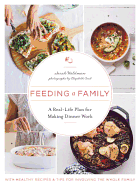
| Publisher: | Roost Books | |
| Genre: | American - General, Health & Healing, Cooking, General, Cooking with Kids, Regional & Ethnic, Cooking for Kids | |
| ISBN: | 9781611803099 | |
| Pub Date: | April 2017 | |
| Price: | $29.95 |
| Food & Wine |
by Sarah Waldman, photographs by Elizabeth Cecil
Sarah Waldman, worried about the direction American mass-produced food is headed, has focused on making nutritious, mostly whole-food meals for her family. Feeding a Family: A Real-Life Plan for Making Dinner Work is the product of a year's labor of love; Waldman made fresh seasonal meals for her husband and two children, and then wrote up the recipes, accompanied here by Elizabeth Cecil's beautiful photographs.
As Waldman puts it, children "are naturally aware of the changing seasons... and we can take a cue from them." She builds her menus around easy, thoughtfully selected options: dense, warm root vegetables in the winter, hydrating melons in the summer. Challenging readers to relax their expectations and just enjoy family dinner time together, Waldman offers many practical tips, such as prepping veggies ahead of time, getting kids involved in the kitchen, and not being worried if occasionally their entire dinner consists of whole wheat bread and butter.
With winter meals such as "Orange and Green Pasta Bowls" (Creamy Pumpkin Fettucine, Pumpkin Seed Pesto and Roasted Broccolini), spring meals like "For the Busiest Night" (Slow Cooker Indian Butter Chicken with Sweet Peas and Lemon-Pecan Shortbread Cookies), Feeding a Family contains more than 100 delicious recipes--each with tips on what the kids can do to help--grouped into 40 seasonal meals.
Simultaneously gorgeous and practical, Feeding a Family is especially good for parents seeking alternatives to bad eating habits and hoping to regain precious family time. --Jessica Howard, blogger at Quirky Bookworm

| Publisher: | Knopf | |
| Genre: | Biography & Autobiography, Women, Personal Memoirs, Literary | |
| ISBN: | 9780451494481 | |
| Pub Date: | April 2017 | |
| Price: | $22.95 |
| Biography & Memoir |
by Dani Shapiro
Don't expect to leave Dani Shapiro's memoir unaltered. Both reader and book are sure to be transformed: notes will mark insights and observations begging to be revisited. Hourglass: Time, Memory, Marriage, novelist and memoirist Shapiro's ninth book and fourth memoir, is a personal yet universal reflection.
In fewer than 150 pages, Shapiro tells of the 18-year marriage ("18 years!" she periodically interjects) with her husband, M, framed by passages from her honeymoon journal. She goes back and forth in their lives: homes, careers, their 16-year-old son's birth, the aging and passing of parents. While Shapiro's eloquence carries the prose, she uses quotes liberally. A Grace Paley observation sets the tone--how the decades between 50 and 80 feel not like minutes, but seconds. A Wendell Berry essay compares the "troubles of duration" in the forms of both poetry and marriage. Referencing Anaïs Nin and Terry Tempest Williams, as well as an anonymous Instagram post advising, "Be who you needed when you were younger," Shapiro explores her life with frankness and intellectual curiosity. M is ever present: "We have formed ourselves over the years as two branches form... reaching ever farther, together." She notes how the challenge of maintaining family security reinforces their bond, since as two writers, "we have nothing to fall back on but each other." Shapiro is droll and down-to-earth (coyotes roam their Connecticut woods, and a woodpecker persists in damaging their shingles), as well as philosophical. As she reaches her conclusion ("19 years!"), she quotes poet Elizabeth Alexander, "We must be gleaners from what life has set before us." --Cheryl Krocker McKeon, manager, Book Passage, San Francisco

| Publisher: | Simon & Schuster | |
| Genre: | Biography & Autobiography, South America, True Crime, United States, Religious, Religion, General, 20th Century, History, Murder, Cults, Latin America | |
| ISBN: | 9781476763828 | |
| Pub Date: | April 2017 | |
| Price: | $28 |
| History |
by Jeff Guinn
Trumpeting assurances of a Promised Land, Jim Jones welcomed followers into his fold. Using intimidation, fear tactics and blatant falsehoods, he kept them there. The volatile religious leader and his Peoples Temple are the focus of Jeff Guinn's The Road to Jonestown. The former investigative journalist records the electrically charged history of events that led up to November 1978's mass suicide. How could a tragedy of such scale occur in apparent devotion to one man? With the same methodical research and meticulous prose that he brought to the chilling biography Manson, Guinn unravels the bewildering rise and fall of the American cult that inadvertently spawned the admonition "Don't drink the Kool-Aid."
Jones began his career as a Methodist preacher in 1953, at the age of 21, building an early following on ideals of integration and socialism. Over time, however, he evolved into a demagogue, enlisting the aid of his politically savvy wife and several unwavering devotees to set about establishing his Peoples Temple. Guinn doesn't flinch at the gruesome details of the preacher's final stand against interlopers encroaching on his supremacy. By 1977, temple defectors were enlisting the help of Congress to retrieve family members from Jonestown, and newspapers were investigating the colony's leadership. As American forces closed in, Jones pulled the trigger. If he couldn't have his paradise, no one would get out alive.
Entering the minds of megalomaniacal mass murderers is a talent of Jeff Guinn's. Nearly 40 years after the fact, he carefully examines how a reckless obsession with power greedily destroyed those in its sway. One hopes that today's demagogues won't get the same satisfaction. --Dave Wheeler, associate editor, Shelf Awareness
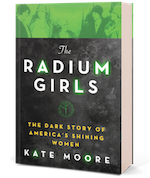
| Publisher: | Sourcebooks | |
| Genre: | Women, United States, World War I, 20th Century, History, Political Science, Technology & Engineering, Labor & Industrial Relations, Toxicology, Industrial Health & Safety, General, Medical, Military | |
| ISBN: | 9781492649359 | |
| Pub Date: | April 2017 | |
| Price: | $26.99 |
| History |
by Kate Moore
British writer and theater director Kate Moore (Scone with the Wind: Cakes and Bakes with a Literary Twist) first encountered the stories of the Radium Girls while producing the play These Shining Lives. She was deeply moved by the 1920s and '30s-era female factory workers who, despite their class, poverty and the agonies of radium poisoning, successfully fought their employers for compensation and lobbied for health and safety legislation that still benefits workers today. When she looked to learn more about them, Moore realized no book existed about the resilient, courageous women from their perspectives, so she set out to write one herself.
In 1917, radium was a glamorous new substance, magical and expensive. It was "a magnificent cure-all"; wealthy people "drank it as a tonic; the recommended dose was five to seven glasses a day." During World War I there was a great need for luminous watch dials, and hand-painting them was one of the most desirable jobs a working-class girl could get. Most were teenagers when they started work, thrilled at their luck, proud of their new earning power. To paint the numerals, they mixed their own radium paint on their work tables, and they were taught to point their fine brushes between their lips.
When the women asked if it might be dangerous to swallow traces of the paint, they were told it was harmless. Thanks to their relatively high wages, they became the stylish glamour girls of their towns. The clinging radium dust made them glow as they walked home in the dark. They took paint home, to paint their faces and decorate the walls. One girl "painted the material all over her teeth one night before a date, wanting a smile that would knock him dead." And then they began to get sick.
Moore's personal passion for the stories of the radium girls is evident in her sympathy for them and in her deep knowledge of every detail of their personal experiences, environments and the laws they fought to change. Moore did extensive research in the United States, interviewing many of the women's families, visiting their workplaces, homes and graves in Illinois and New Jersey, and studying court documents, letters and personal diaries.
The physical and emotional suffering of these women as their radiation poisoning advanced makes for harrowing reading, and Moore describes it with all the merciless detail that one of their outraged doctors or loving relatives might want the world to know. Their bones thinned and snapped, they grew dreadful tumors, their mouths and throats rotted away and their jaw bones deteriorated. Once embedded in their bodies, the radium was impossible to remove. When one of the first girls to die was exhumed for an autopsy to prove she had died of radium poisoning, the unearthed coffin "seemed to glow with an unnatural light."
Doctors and dentists were bewildered by the symptoms and eventually grew suspicious of the true cause. Their concerns finally spread to the United States Radium Corporation, which launched an investigation in 1924 headed by a Harvard physiologist. When the findings indicated that radium was indeed dangerous, the corporation tried to cover up the research.
Legal recourse for industrial diseases was extremely limited at this time, and the industry wanted to keep it that way. They did all they could to suppress scientific evidence and deny the workers' claims. But the dial painters banded together, encouraged each other and found good attorneys. They filed lawsuits for compensation and lobbied for new legislation to protect all industrial workers. As evidence and deaths mounted, the FDA and the AMA turned against radium in products and medicine. New health and safety standards concerning the material were put in place just in time to protect individuals working with radium and other dangerous materials during World War II. The Radium Girls follows these young women through their trials and tribulations at a breakneck pace while providing impressive details in character lists, notes and citations.
The poor, working-class Radium Girls stood up to power and wealth together. And even though no one could save most of their lives, they won justice for themselves and future generations of industrial workers. --Sara Catterall
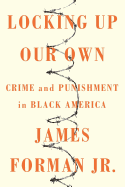
| Publisher: | Farrar, Straus & Giroux | |
| Genre: | Law Enforcement, Penology, Social Science, African American Studies - General, Ethnic Studies, Criminology, Political Science | |
| ISBN: | 9780374189976 | |
| Pub Date: | April 2017 | |
| Price: | $27 |
| Social Science |
by James Forman Jr.
In Locking Up Our Own, Yale Law professor James Forman Jr. uses comprehensive research, his personal experience as a public defender in Washington, D.C., and an open mind to illustrate how the crisis of mass incarceration in the United States was constructed incrementally over a 40-year period, examining in particular the role that African Americans unwittingly played in that effort, which has made the U.S. the world's largest jailer.
Part one looks at the origins of mass incarceration: the war on drugs, gun control and the rise of African Americans in politics and law enforcement. Despite some successful state-level efforts in the 1970s to decriminalize marijuana, black lawmakers and communities railed against the movement. In this area, as in others Forman covers, the logic behind lawmakers' and voters' decisions to be tough on crime is an effort to help the African American communities. However, they result in different consequences altogether, which Forman goes on to examine in the second half of his book.
Forman's comprehensive research and analysis, as well as his compassion and personal experiences, make Locking Up Our Own a powerfully important and accessible glimpse at the U.S.'s punitive criminal justice system. His observation that the country always makes room in prisons, but can't do the same in drug treatment centers, is telling of misplaced priorities. Furthermore, he recognizes that repetitive efforts to treat root problems such as education, income inequality, employment and health care rarely, if ever, take precedence over punishment. Forman's voice is one of logic and reason, and in his epilogue it is also one of benevolence: "What if we strove for compassion, for mercy, for forgiveness?" --Jen Forbus, freelancer

| Publisher: | Philomel | |
| Genre: | Health & Daily Living, Romance, General, Social Themes, Young Adult Fiction, New Experience, Diseases, Illnesses & Injuries | |
| ISBN: | 9780399547010 | |
| Pub Date: | May 2017 | |
| Price: | $15.99 |
| Starred | Children's & Young Adult |
by Emily Barr
Flora Banks is 17 years old, but she knows this only because it's written on her hand. She can't remember anything that's happened since she was 10, when a brain tumor left her unable to make new memories. Flora writes lots of things on her hand, like "Don't drink alcohol" at the party for her best friend Paige's boyfriend, Drake, who leaves tomorrow for Svalbard, Norway. But Flora does have a cup of wine, and she winds up on the beach kissing Drake. And, incredibly, Flora remembers!
Unfortunately, Paige finds out. When Flora's parents leave for Paris to be with Flora's dying brother, Jacob, they think Paige will "babysit" Flora. Except Paige doesn't want anything to do with Flora anymore. Flora knows that if she can just find Drake, her brain will work again, so before long she has written enough notes on her hand, in her notebook and on her phone to enable her to buy a plane ticket from Cornwall, England, to Svalbard, where she intends to kiss Drake and "remember it to infinity."
Flora's resourcefulness in overcoming her disability, along with her determination to gain some measure of autonomy from overprotective parents, makes her a strong and appealing character. In her YA debut, Emily Barr (author of the adult novel Backpack) does a terrific job portraying how disorienting life must be for someone who can't remember what she does for more than two or three hours at a time. Life is always a mystery, yet Flora persists. Certainly, the most important advice she can give herself is etched right onto her hand: "Flora, be brave." --Lynn Becker, blogger and host of Book Talk, a monthly online discussion of children's books for SCBWI
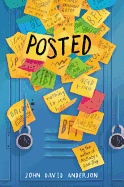
| Publisher: | Walden Pond/HarperCollins | |
| Genre: | Bullying, Friendship, Fantasy & Magic, School & Education, Social Themes, Juvenile Fiction, Action & Adventure | |
| ISBN: | 9780062338204 | |
| Pub Date: | May 2017 | |
| Price: | $16.99 |
| Children's & Young Adult |
by John David Anderson
In a small Michigan town, four eighth-grade boys make up their own "tribe": Frost (nicknamed for winning a poetry contest in fifth grade), Bench (because he's more bench-warmer than active player), Deedee (for his Dungeons & Dragons obsession) and Wolf (because he's a Wolfgang Amadeus Mozart-esque piano prodigy). The foursome's tightness is all the proof Frost needs to prove his "theory of socio-magnetic-homogeny... [which] basically says that people gravitate toward people who share their interests and whatnot." And then there's the rest of their classmates, who just call them "the dork patrol."
Six weeks into the school year, Rose--who used "her actual name"--arrives at Branton Middle School during a time of great upheaval for the student body--cell phones have just been decisively banned during school hours. Frost presciently takes note: "[S]ometimes somebody shows up in your life and throws everything out of whack." Suddenly, the boys' once-perfect square must accommodate Rose, a misfit by many standards. Meanwhile, without access to virtual communication, students have gone analog, resorting to Post-Its tacked up on lockers, bathrooms, even foreheads; too soon, missives turn novelty to cruelty, with disastrous results.
Despite occasional missteps (an eighth-grade boy without any interest in ballet probably wouldn't rattle off a reference to a pas de bourree), Anderson (Mr. Bixby's Last Day) maneuvers his "tribe" through school lunches, the infamous Gauntlet, imploding parental relationships and confessions in disguise. Moving effortlessly from Elizabethan drama to Ghostbusters to gamer Gary Gygax, Anderson's latest is sure to elicit both recognition and empathy from his intended middle school audiences. --Terry Hong, Smithsonian BookDragon
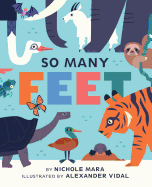
| Publisher: | Abrams Appleseed | |
| Genre: | Concepts, Animals, General, Environment, Nature & the Natural World, Body, Juvenile Fiction | |
| ISBN: | 9781419723186 | |
| Pub Date: | May 2017 | |
| Price: | $12.95 |
| Children's & Young Adult |
by Nichole Mara, illust. by Alexander Vidal
Small readers are drawn to small things: caterpillars, pebbles, body parts. So Many Feet is a celebration of that fascination. Sticky feet, jumping feet, wet feet, blue feet: nature is masterful in its adaptations. A sloth's "hook-like claws allow it to hang from tree branches." A polar bear has feet that "spread wide to keep it from sinking into the snow." And the shovel-snouted lizard "moves quickly so the hot desert sand doesn't burn its feet."
Each spread in this irresistible board book portrays a different creature in its stylized habitat. Orange kangaroos jump right out of the frame through a pinkish desert landscape. An adorable gray mole pops out of the brown earth next to a fat, pink earthworm and a geometric bug. Against a snowflake-studded periwinkle sky, polar bears gaze coolly outward, an unconcerned puffin perched on a rock nearby. Nichole Mara's one-sentence descriptions with headings ("PICKY FEET," "SCRATCHY FEET," "SLOW FEET") pair cleanly with debut illustrator Alexander Vidal's crisp, flat, artful pictures.
Aimed at tots who are just beginning to ask the "why"s and "how"s of the world, So Many Feet helps readers understand that nature has a reason for everything--geckos must have sticky feet to climb up walls, and elephants stomp their feet to warn each other of danger. A final spread asks "What can YOUR FEET do?" Like Matthew Van Fleet's Tails, So Many Feet will have readers begging for repeated out-loud readings. --Emilie Coulter, freelance writer and editor